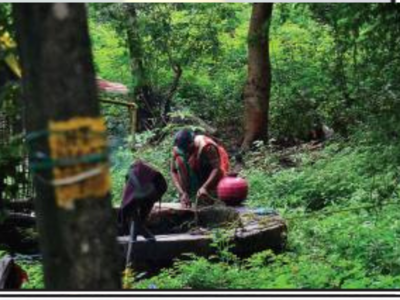
PANAJI: Not only has the process for re-estimating Goa’s ground water commenced as on March 2020, new regulations on groundwater governance are also on the anvil for the state based on the July 2020 order of the National Green Tribunal. In its order, the NGT has specifically banned “general permission for withdrawal of groundwater”, especially to commercial entities, without an environment impact assessment.
On Tuesday, the first meeting of the state-level committee for re-estimation of Goa’s groundwater was held in Panaji. The meet was chaired by state secretary for water resources and IAS officer Sanjay Gihar, representatives from the Bengaluru office of the central ground water board, chief engineer of Goa’s water resources department Shrikant Patil, as well as representatives from different other related departments in Goa.
The NGT’s order in July had stated that permits issued for groundwater usage have to be for specified quantity of water and cannot be valid for perpetuity. Usage of water permitted should be monitored with digital flow metres and audited every year by third parties, the NGT had said. Swift action, including blacklisting and prosecution, should be taken against those who fail the audit, stated the order.
The central ground water board in its report last year had stated that the overall groundwater availability scenario in Goa remains safe, but a ‘negligible to moderate’ fall in water level was recorded during the premonsoon season. The board report showed that groundwater consumption has gone up in Goa.
This report was, however, based on groundwater re-estimation up to March 2017.
Now, a more recent review of the groundwater situation in Goa is being carried out. Increase in population, tourism and commercial activities is a concern. The central board’s report had agreed that the loss due to the natural discharge is 40% for Goa as against the recommended figure of 5%. This was because in case of Goa the terrain is highly undulating and laterite formations are highly porous.
On Tuesday, the first meeting of the state-level committee for re-estimation of Goa’s groundwater was held in Panaji. The meet was chaired by state secretary for water resources and IAS officer Sanjay Gihar, representatives from the Bengaluru office of the central ground water board, chief engineer of Goa’s water resources department Shrikant Patil, as well as representatives from different other related departments in Goa.
The NGT’s order in July had stated that permits issued for groundwater usage have to be for specified quantity of water and cannot be valid for perpetuity. Usage of water permitted should be monitored with digital flow metres and audited every year by third parties, the NGT had said. Swift action, including blacklisting and prosecution, should be taken against those who fail the audit, stated the order.
The central ground water board in its report last year had stated that the overall groundwater availability scenario in Goa remains safe, but a ‘negligible to moderate’ fall in water level was recorded during the premonsoon season. The board report showed that groundwater consumption has gone up in Goa.
This report was, however, based on groundwater re-estimation up to March 2017.
Now, a more recent review of the groundwater situation in Goa is being carried out. Increase in population, tourism and commercial activities is a concern. The central board’s report had agreed that the loss due to the natural discharge is 40% for Goa as against the recommended figure of 5%. This was because in case of Goa the terrain is highly undulating and laterite formations are highly porous.

Coronavirus outbreak
Trending Topics
LATEST VIDEOS
City
 On cam: Elderly woman brutally thrashed for objecting to eve-teasing in Ghaziabad
On cam: Elderly woman brutally thrashed for objecting to eve-teasing in Ghaziabad  Odisha: 4-feet-long cobra rescued from a toilet in Ekachalia village
Odisha: 4-feet-long cobra rescued from a toilet in Ekachalia village  On cam: 35-year-old woman dies of electrocution after she steps on a live wire in Chennai
On cam: 35-year-old woman dies of electrocution after she steps on a live wire in Chennai  Government prohibits onion exports as prices treble in a month
Government prohibits onion exports as prices treble in a month
More from TOI
Navbharat Times
Featured Today in Travel
Quick Links
Kerala Coronavirus Helpline NumberHaryana Coronavirus Helpline NumberUP Coronavirus Helpline NumberBareilly NewsBhopal NewsCoronavirus in DelhiCoronavirus in HyderabadCoronavirus in IndiaCoronavirus symptomsCoronavirusRajasthan Coronavirus Helpline NumberAditya ThackerayShiv SenaFire in MumbaiAP Coronavirus Helpline NumberArvind KejriwalJammu Kashmir Coronavirus Helpline NumberSrinagar encounter
Get the app



